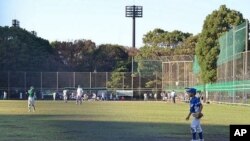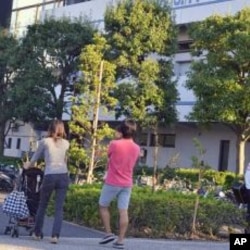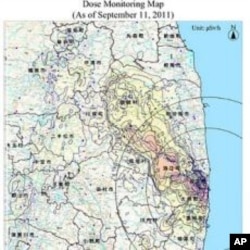Residents in the greater Tokyo metropolitan area, the world's most populous with about 33 million people, have taken radiation monitoring into their own hands. They are making some unexpected discoveries following the March tsunami damage to the Fukushima-1 nuclear power plant.
Uninformed parents
Just meters from where a hot spot of radioactive cesium was confirmed days before by a private laboratory, a Little League baseball game was underway Sunday.
The players, their parents and the spectators, mostly neighborhood residents, unaware that some of the dirt here has tested equivalent to four times the minimum level of the contaminated zones from the 1986 Chernobyl accident in Ukraine.
While the news about the Edogawa municipal ballpark complex had been reported overseas, including on the front page of Saturday's New York Times, it had yet to be mentioned in Japan's mainstream media.
Between two of the ball fields, the Odaka family was walking in a small park with their four year-old daughter.
Odaka (who wanted to be identified only by his family name) says he and his wife had not heard anything about the radiation here, nearly 250 kilometers from the reactors that leaked radiation in the days after a huge earthquake and tsunami hit Japan's northeastern Pacific coast on March 11.
He says he would like to know more about the source of the information relayed to him by VOA News. He says the government should evaluate this information and properly inform the public.
If the area is radioactive, then the government, he adds, should decontaminate the area.
Concerns
Two mothers watching their elementary school age boys playing in a league baseball game, also expressed surprise when asked by VOA News about the adjacent contaminated soil.
The women agree that they have heard numerous general reports about radiation since the March disaster, but felt they could not be overly concerned or they would not be able to go on with their daily lives.
But this is the first time they have heard about a high level of radiation in their own neighborhood. In the nearby city of Yokohama, higher than normal levels of radioactive strontium have been found at three locations.
The suspect materials were analyzed by a private company in Yokohama that charges entities to analyze soil, sediment and food samples for various types of radiation. The Isotope Research Institute is reported to have analyzed thousands of samples sent by citizens, ranging from swimming pool water to breast milk, in the past seven months.
Hot spots
Another hot spot has been uncovered in a children's theme park in Chiba Prefecture, which is adjacent to Tokyo. The reported level of radiation there is higher than in an evacuated village in Fukushima, 45 kilometers from the crippled plant.
Citizen monitoring last week also detected abnormal levels of airborne radiation on a sidewalk on the path to a primary school in an upscale Tokyo neighborhood (in Setagaya ward). That case, however, appears not related to the Fukushima nuclear plant.
Government officials say the radiation source was found under the floor of a nearby house, old bottles containing radium powder. Radium was previously used as a luminous paint to make watch and clock faces glow in the dark.
The incidents have prompted Japan's government to order the science and environment ministries to boost monitoring of radiation levels.
But local and central government officials say the isolated hot spots outside Fukushima are not a cause for alarm because no one spends such an extended period of time at such spots to absorb doses that would harm their health.
They also are expressing skepticism about some of the highest reported readings from citizens, saying they could be erroneous as uncalibrated small dosimeters can be very inaccurate.
Radiation in sea life off the Fukushima coast and its effects on the food chain also remain a concern. Researchers at the Tokyo University of Marine Sciences and Technology say samples of plankton collected in July exhibited high levels of radioactive cesium. Many fish feed on plankton.
But the scientists say it is too soon to conclude a serious risk to humans. Some species of fish caught off Japan's Pacific Coast since the reactor meltdowns have also been found to be contaminated and Japanese authorities moved to halt those fish from being sold.














